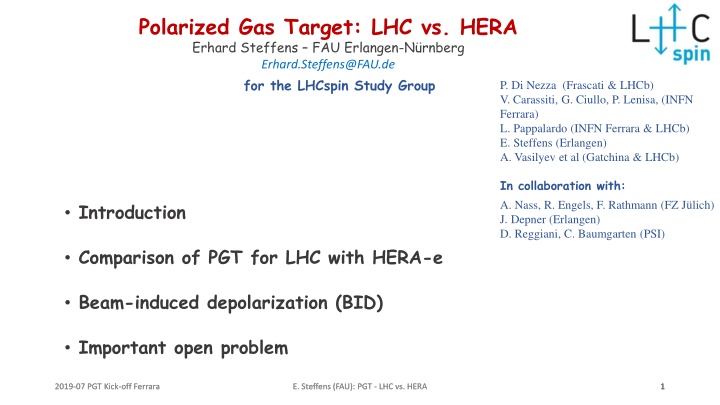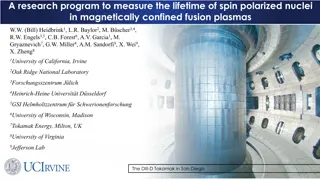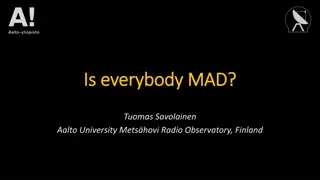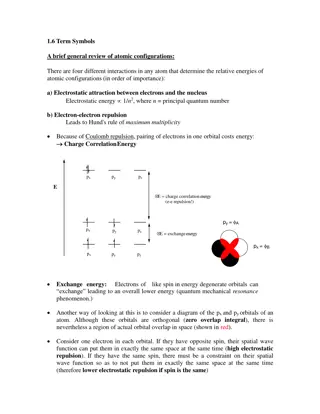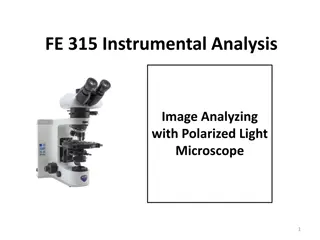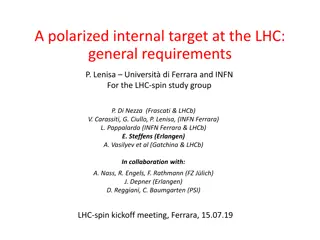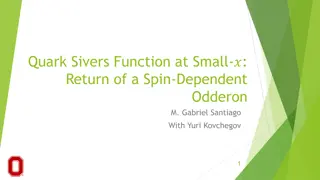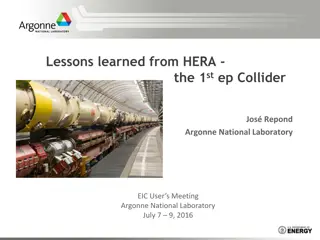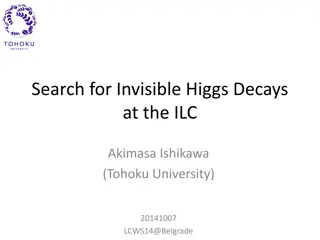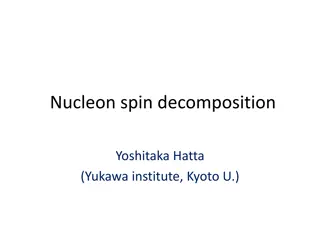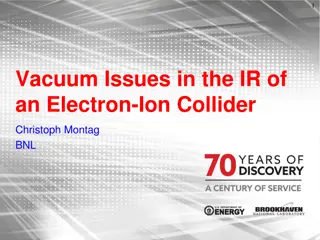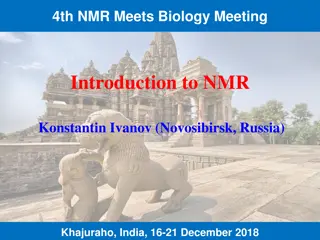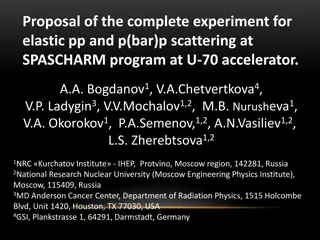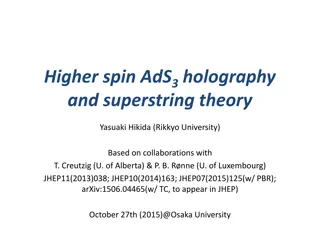Comparing Polarized Gas Targets at LHC and HERA for Spin Studies
The comparison between Polarized Gas Targets (PGT) at the Large Hadron Collider (LHC) and HERA for spin studies is discussed. Key considerations such as beam-induced depolarization, beam parameters, and design aspects are highlighted. The importance of using a polarized gas target similar to HERMES for achieving high target polarization is emphasized. Insights from HERMES' experience with storage cell technology and beam-induced depolarization studies are also shared.
Download Presentation

Please find below an Image/Link to download the presentation.
The content on the website is provided AS IS for your information and personal use only. It may not be sold, licensed, or shared on other websites without obtaining consent from the author.If you encounter any issues during the download, it is possible that the publisher has removed the file from their server.
You are allowed to download the files provided on this website for personal or commercial use, subject to the condition that they are used lawfully. All files are the property of their respective owners.
The content on the website is provided AS IS for your information and personal use only. It may not be sold, licensed, or shared on other websites without obtaining consent from the author.
E N D
Presentation Transcript
Polarized Gas Target: LHC vs. HERA Erhard Steffens FAU Erlangen-N rnberg Erhard.Steffens@FAU.de for the LHCspin Study Group P. Di Nezza (Frascati & LHCb) V. Carassiti, G. Ciullo, P. Lenisa, (INFN Ferrara) L. Pappalardo (INFN Ferrara & LHCb) E. Steffens (Erlangen) A. Vasilyev et al (Gatchina & LHCb) In collaboration with: A. Nass, R. Engels, F. Rathmann (FZ J lich) J. Depner (Erlangen) D. Reggiani, C. Baumgarten (PSI) Introduction Comparison of PGT for LHC with HERA-e Beam-induced depolarization (BID) Important open problem 2019-07 PGT Kick-off Ferrara 2019-07 PGT Kick-off Ferrara E. Steffens (FAU): PGT - LHC vs. HERA E. Steffens (FAU): PGT - LHC vs. HERA 1 1
Comparison HERA(e) LHC(p) Beam parameter HERA (e) LHC (p) Emax /GeV Lorentz Ibeam/A Raverage /m PSRprop. 4 Ibeam /R [A/m] 27.5 7 000 final beam energy 53 816 7 463 0.06 1.1 (HL-LHC) 1 000 4 260 m 5.03 1014 8.01 1011 total PSR (PLHC 1.6 10-3x PHERA) Self-polarization yes ( pol. beam) no ( unpol. beam) Instabilities damping to equilibr. emittance (cooling) no damping, i.e. kicks add up instab. grow Efinal / Einj geom. = invariant / adiabatic shrinking during acceleration 27.5 / 14 = 2.0 geom at injection 2 x bigger 7 000 / 450 = 15.6 geom at injection 16 x bigger HERA: fixed collimator and cell; LHC: narrow passages to open during injection! 2019-07 PGT Kick-off Ferrara 2019-07 PGT Kick-off Ferrara E. Steffens (FAU): PGT - LHC vs. HERA E. Steffens (FAU): PGT - LHC vs. HERA 2
Overview: Polarized Gas Target for the LHC Design considerations for a PGT Physics accessible at LHC (unpolarized beam!): Single Spin Azimuthal measured with transverse polarization of the target STand -dependence of the final-state hadrons. Required: Polarized gas target similar to HERMES (see sketch), incl. Atomic Beam Source (ABS), Storage Cell (SC) target with strong transverse guide field, target gas analyzer (TGA) and polarimeter (BRP), powerful differential pumping, etc. Asymmetries (SSAA), All narrow openings in the LHC, like the VELO detector, have to be openable during injection and tuning (rmin 27 mm at IP8). This holds for the PGT set-up as well, with cell, wake field suppressors, detectors, diaphragms etc. 2019-07 PGT Kick-off Ferrara 2019-07 PGT Kick-off Ferrara E. Steffens (FAU): PGT - LHC vs. HERA E. Steffens (FAU): PGT - LHC vs. HERA 3
What can we learn for the LHC target from HERMES? Concept of Storage Cell, fed by ABS, with Sampling Polarimeter (TGA +BRP) is proven technology: pure target of high polarization. Experience with cell Coating! Cold cell surface ( 100 K) with water coating: best performance. Transverse running 2002 2005: Beam-induced depolarization (BID) studied experimentally extrapolation to performance with LHC beam! 2019-07 PGT Kick-off Ferrara 2019-07 PGT Kick-off Ferrara E. Steffens (FAU): PGT - LHC vs. HERA E. Steffens (FAU): PGT - LHC vs. HERA 4
HERMES hydrogen/deuterium target A. Airapetian et al, Nucl. Instr. and Meth. A540 (2005) 68 Operated 1996 2000 with long. pol. (H, D) and 2002 2005 with transverse H target Atomic Beam Source (ABS) with permanent sextupole magnets and a flexible system of rf-transitions in between and after the 6-poles, allowing for a high vector (Pz for H & D) and tensor (Pzz for D) polarization of the target gas. Absolute polarimeter, consisting of a Target Gas Analyzer (TGA = degree of dissociation) and a BR-polarimeter (BRP substate population ni). Simulations of the molecular flow allow one to relate the density-averaged target polarization P and degree of dissociation to the parameters mea- sured on the sample beam extracted in the cell center. The average number of wall collisions for an atom during its passage through the cell is about 300, imposing a high demand on the quality of the cell wall. The better the wall, the higher Pav is, and the more uniform the distribution of polarization and along the cell will be. 5 2019-07 PGT Kick-off Ferrara 2019-07 PGT Kick-off Ferrara E. Steffens (FAU): PGT - LHC vs. HERA E. Steffens (FAU): PGT - LHC vs. HERA
Rough comparison (see table) At HERA, the target was located in a separate electron beam line. Strong pumping (2x TPH-2200) with unlimited capacity was applied on the target chamber. Beam-induced depolarization (BID) by the bunch fields has to be suppressed by proper (non-resonant) choice of the guide field. At the LHC, a future PGT will be located in an evironment with NEG-coated surfaces of very limited capacity*. For positive beam charge, the formation of E- clouds and the accompanying instability must be prevented, i.e. the surfaces close to the beam must have low Secondary Emission Yield (SEY). Here these surfaces is extremely important! transverse Consequently, the gas flow into the neighboring chambers has to be mimized, e.g. the on-axis flow from the target cell. the coating of Such limits will enter the design value of the PGT gas flow rate which could be 10x higher than for SMOG2 which is located in the VELO vessel. *) Regeneration: baking huge effort! e.g. VELO vessel: venting, removal of detectors possible during shut-down, only! 2019-07 PGT Kick-off Ferrara 2019-07 PGT Kick-off Ferrara E. Steffens (FAU): PGT - LHC vs. HERA E. Steffens (FAU): PGT - LHC vs. HERA 6
Beam-induced depolarization (BID) After its 1stobservation at VEPP-3, this effect has been studied at HERMES, see first measurement with Blong publ. in PRL 82 (1999) 1164, and analyzed together with Btransvin Diss. Ph. Tait, Erlangen (2006): http://www.hermes.desy.de/notes/pub/06LIB/pntait.0 6-060.thesis.ps.gz . 1 - 2 2 - 4 Hydrogen hfs diagram Bcrit = 50.7 mT 3 - 4 BID is based on resonant transitions caused by the beam field acting on the polarized H-atoms in an external guide field B0 300 mT. There are different classes of transitions, depending on the relative orientation of the guide field B0and B1, the beam field component. resonances for B1 B0 F = 0, 1 mF= 1, and resonances for B1 B0 F = 1 mF= 0. Some of these resonances change nuclear polarization. For longitudinal guide field, only the resonances are present. For transverse field, like at LHCspin, both types of resonances are present. The resonances, interchanging states 2 and 4, are densely spaced, i.e. its prevention requires a very high homogeneity of the guide field. 2019-07 PGT Kick-off Ferrara 2019-07 PGT Kick-off Ferrara E. Steffens (FAU): PGT - LHC vs. HERA 7
Transverse guide field magnet (HERMES) In order to resolve the 24resonances, a field homogeneity in the order of their spacing is required (0.37 mT in the high-field limit). A special magnet with large gap height and high field quality had been built. With the help of shims and correction coils a high homogeneity could be achieved. 2019-07 PGT Kick-off Ferrara 2019-07 PGT Kick-off Ferrara E. Steffens (FAU): PGT - LHC vs. HERA E. Steffens (FAU): PGT - LHC vs. HERA 8
Observation of the resonances A practical method to detect the resonances was the wide range Flip-in method: States |1> and |4> are injected by the ABS, and states |2> and |3> are mea- sured by the BRP. With e beam, the population of the cell gas is changed and detected by the BRP. As an example, the BRP rate is shown as function of the current I in the transverse magnet. The reso- nances 3-4 and 1-2 are clearly visible. At high field the spacing is wide, and individual resonances can be easily selected. This is different for the 24resonances with narrow spacing. In order to suppress them, the B-field must be set to the minimum in-between. Wide Range measurement of the resonances induced by the beam field. At high field, individual resonances can be selected. 2019-07 PGT Kick-off Ferrara 2019-07 PGT Kick-off Ferrara E. Steffens (FAU): PGT - LHC vs. HERA E. Steffens (FAU): PGT - LHC vs. HERA 9
HERMES transverse Running (2002-2005) During transverse running (2002 2005), careful studies to optimize the target polari- zation have been performed - see a final result of Diss. Tait on the 24resonance taken by the target polarimeter (BRP) where the nuclear polarization Pz is shown as function of B0. Two polarization minima caused by the 24 resonances are clearly visible at a distance in field of about 0.36 mT as expected, demon- strating the high field quality of this rather open magnet. For the WP in between the resonances, a 2% increase in P is obtained. 2019-07 PGT Kick-off Ferrara 2019-07 PGT Kick-off Ferrara E. Steffens (FAU): PGT - LHC vs. HERA E. Steffens (FAU): PGT - LHC vs. HERA 10
Comparison of BID for HERA and LHC Key parameters of both machines: z cm t ps = 1/ t2 ps2 NBunch fBunch MHz Ibeam A 1/e width of Fourier spectrum I0 Peak current (A) Machine 210 2600 5.203 10-45.1 GHz 7.81 10-6 HERA-e LHC 10.41 40.08 0.04 0.93 1.0 31 253 57.3 41.2 7.55 0.63 GHz Assumptions: 1. The trajectories of the MolFlow simulation are equivalent (see Tait Fig. 4.7 on the right: trajectories are shown in red, blue dots at cell wall are wall bounces, blue dots within the cell: crossings of a resonance). 2. Inhomogeneity equivalent, i.e. the shape of the resonant surfaces are similar (see Tait Fig. 4.6) duration of resonance crossings have the same statistical distribution. 3. Beam size very small compared to cell radius 4. The main differences come from the bunch frequency, and the longitudinal width in z or in t ( z/t) (see Table). 2019-07 PGT Kick-off Ferrara E. Steffens (FAU): PGT - LHC vs. HERA 11
Comparison of BID for HERA and LHC Spin-flip Probability for crossing a 2-4 resonance, with = mixing angle, = crossing time and n index of passage (Tait Equ. 4.11): In summary, the main differences between HERA-e and LHC are: Bunch frequency fB: 10.41 MHz vs. 40.08 MHz. This results for the LHC in a 4x larger spacing of the resonant B-values , i.e. it reduces requirements on field quality. Width of the Fourier spectrum: 5.1 GHz vs. 0.63 GHz. This leads to a rapid fall-off of the relevant Fourier amplitudes of the 2-4resonance (8.54 GHz) at the LHC. The comparison suggests that BID at the LHC is less dangerous as at HERA-e! - Clearly, this needs to be confirmed by a systematic study of BID at the LHC! B|| is the RF field parallel to B0 (guide field, 300mT), B|| = B0 for = 90 . With our assumptions, we estimate the relative strength of BID by the ratio of the square of B|| for both beams. For the k-th harmonic of the Fourier spectrum (Tait 2.59) we obtain at the 2-4 transition frequency of 8.54 GHz with the parameters of the table LHC: F213= 2 1.0 A 1.53 10-20 HERA: F820= 2 0.04 A 7.53 10-2 We conclude that resonant depolarization at the LHC via the 2-4transition is negligible compared to HERA, despite the 25x higher beam current! 2019-07 PGT Kick-off Ferrara 2019-07 PGT Kick-off Ferrara E. Steffens (FAU): PGT - LHC vs. HERA E. Steffens (FAU): PGT - LHC vs. HERA 12
Estimate of the areal density of the PGT Assumed: IH(100 % HERMES ABS flow) = 6.5 1016/s, may be limited by LHC vacuum constraints or space limitations for the PGT; Cell 30 cm long, 1.0 cm i.d., at 100K, with standard feed tube 10 cm long, 1.0 cm i.d. The resulting 100% density of the polarized gas target is = 1.2 1014/cm2, comparable with HERMES. For the future HL-LHC-25ns, the Luminosity achievable with the PGT would be up to 8.3 1032/ cm2s. To which extent such densities can be realized and exploited in a real experiment, depends on many factors and has to be investigated in more detail. 2019-07 PGT Kick-off Ferrara 2019-07 PGT Kick-off Ferrara E. Steffens (FAU): PGT - LHC vs. HERA E. Steffens (FAU): PGT - LHC vs. HERA 13
Important open problem (there are more) Cell surface with a-C coating: needs a thin water/ice layer to suppress recombination (and thus depolarization) see HERMES measurement indicating close-to-zero recombination! A water layer can be produced in dynamical equi- librium by injecting a low water fraction together with the polarized H atoms, set by the O2admix- ture in the dissociator gas H2. The setting of Tcell has a strong effect, too; i.e. lowering T results in a thicker water layer at the same O2flow. The SEY of this surface is not known to us and needs to be studied. HERMES-target: Degree of dissociation as function of the cell temperature T. The cell was in use for an extended period (not a new cell). note: = 1 indicates no molecules detected by TGA! 2019-07 PGT Kick-off Ferrara 2019-07 PGT Kick-off Ferrara E. Steffens (FAU): PGT - LHC vs. HERA E. Steffens (FAU): PGT - LHC vs. HERA 14
Thank Thank You You ! ! 2019-07 PGT Kick-off Ferrara E. Steffens (FAU): PGT - LHC vs. HERA 15
